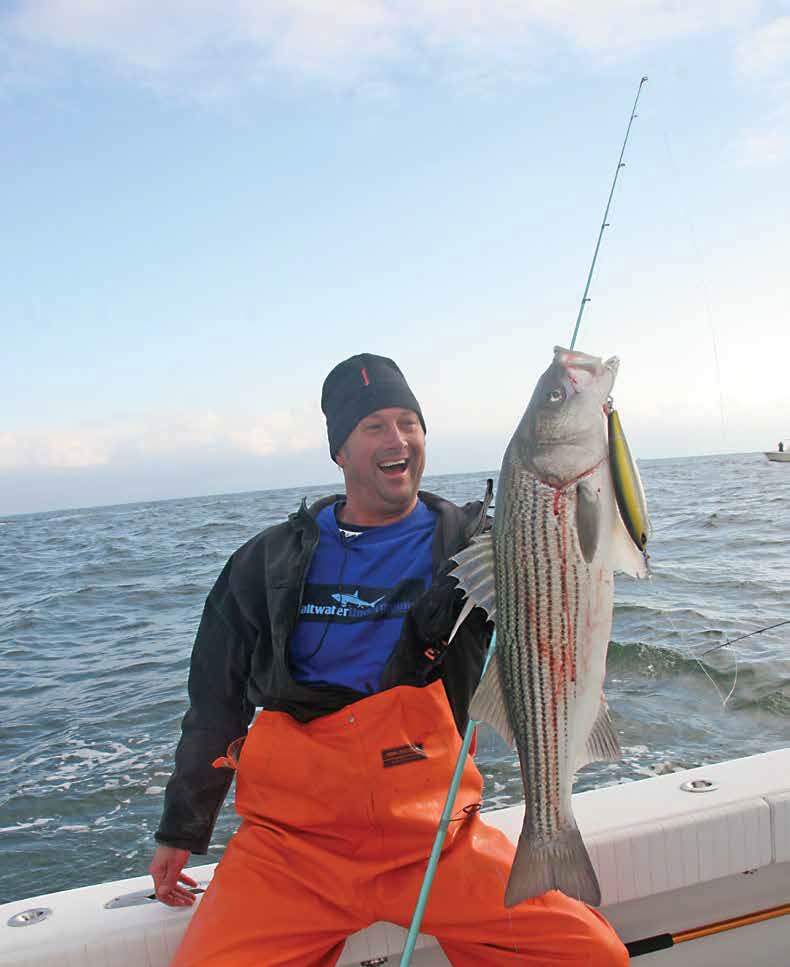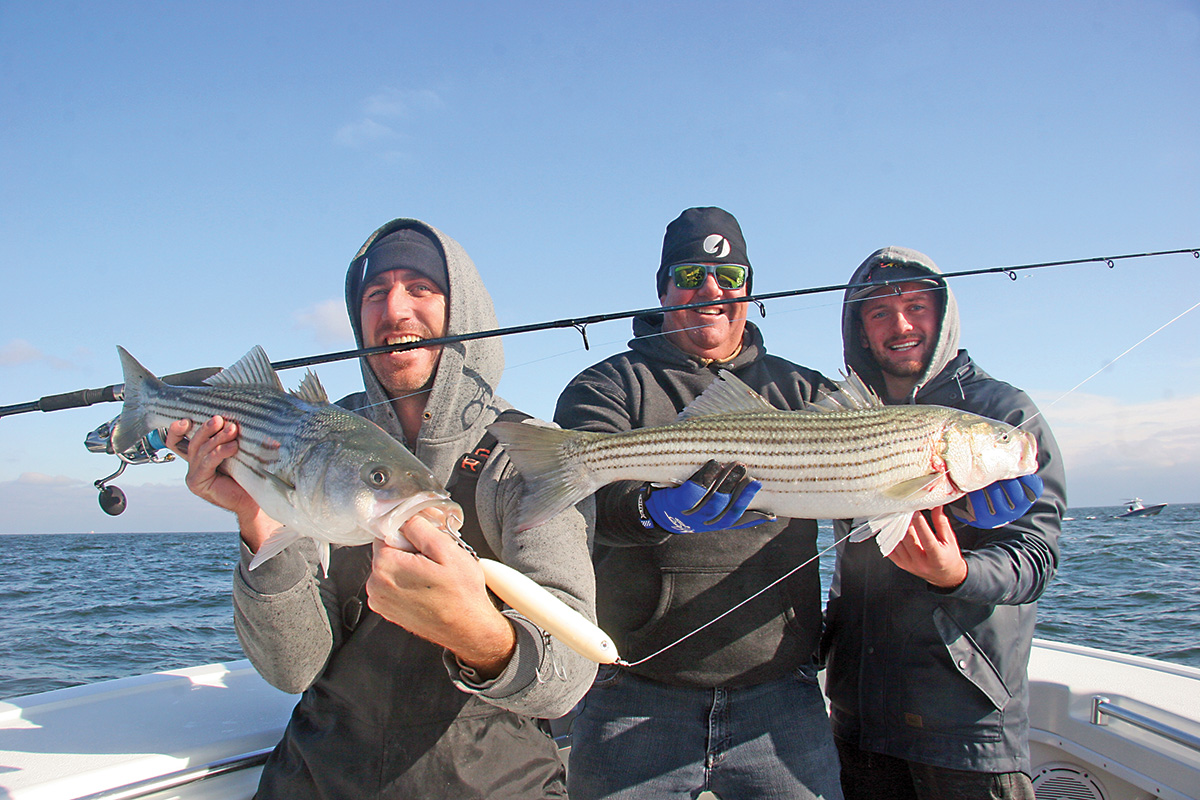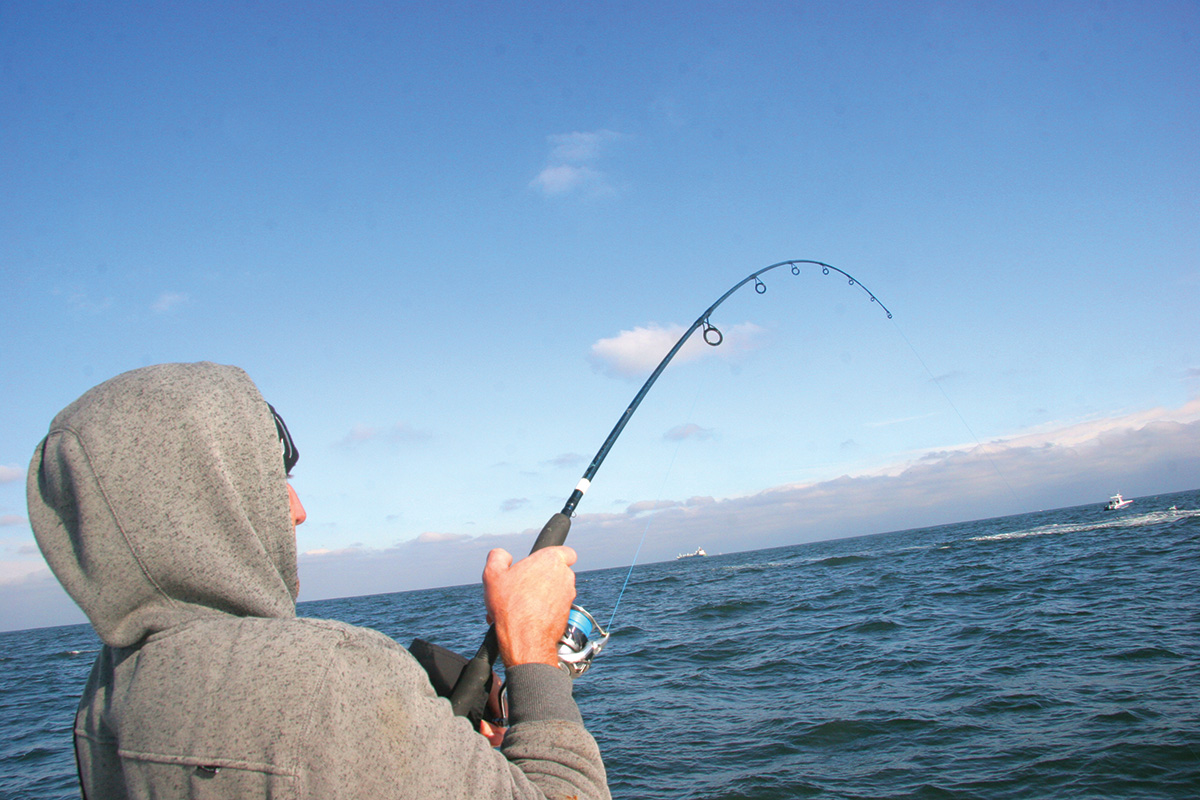
Striper schools were in solid. I hung a trip with Capt. Gene Quigley on his Reel Freedom filming an episode of my online TV series called Saltwater Underground (www.saltwaterunderground.com) and we needed the bass to cooperate.
As is usually the case when filming, the fish can be camera shy, and as we livelined bunker, we only had a few run offs with one 25-pound release. Then we figured to make a move and switched up tactics to topwater poppers, knowing bass were on an aggression strike. Two moves later, let’s just say we made the show. With five guys on the boat, all of us were hooked up on poppers, pulling in bass from shorts to 25 pounds for four hours straight.
It may sound funny, but poppers work best in two scenarios; when bass are aggressively feeding and when they’re not. In other words, when they are in a frenzy aggression striking and when they need to be convinced to hit.
All Balled Up
Schools of bunker have been flooding the nearshore waters in May and June with large striper schools hanging underneath and around the outskirts picking off bunker one by one to fill their hungry guts. When bass are pushing bunker out of the water and the telltale roostertails of bunker fleeing in whitewater are clear—which usually occurs from the pre-dawn hours up until about 10 a.m.—it’s prime time to sling poppers at the aggressively feeding stripers.
Try casting poppers on the outskirts of active bunker schools, working the popper back almost in a slow side to side roll to present an injured appearance. Pencil poppers from Gibbs, Yo-Zuri and Tsunami work well in terms of keeping your presentation in the strike zone the longest. A 7-foot Penn Slammer rod matched with a 10000 class reel works to clear the T-top rodholders and effectively wing out a popper or stickbait. The key is to pull the fish off of the bunker schools; keep working that popper all the way back to boatside. A charged-up bass thinking it’s chasing a wounded bunker will follow it all the way until it runs into the boat. When filming, we actually had three to four bass fighting over the popper at boatside and even employed the ol’ muskie technique of “figure-eighting” the popper next to the boat where they eventually pounced on it.

Create Custom Blitzes
Along the oceanfront, sometimes you can be marking bait with no visible signs up top except for an occasional tern diving or gannet crashing into the water. When there really are no visible signs, creating commotion on the water’s surface will attract any fish in the vicinity to come inspect the activity. Cup faced poppers like the Yo-Zuri Bull Popper, Williamson Popper Pro stickbait, or the large Super Strike Little Neck spray up plenty of attention grabbing water.
Subtle giveaways such as surface rippling or circling birds can alert you to bass in the area. Stripers usually push off to the deeper 60- to 70-foot depths by noon and will stay out there late in the afternoon before they push back in during evening hours. Open ocean popping can sometimes seem like a fruitless endeavor, but if you mark bait or bass in the area, give the plugs a chance to work their magic. Action breeds action; with three guys casting poppers, any bass in the area will most certainly come to inspect what’s going down and pounce with a reaction strike.
Bay Trippin’ Bass
You don’t have to hit the Atlantic to get in on the popping scene. Back-bay areas in Jamaica Bay, the western South Shore bays, Great South Bay, and Moriches and Shinnecock bays are holding pens for resident stripers. The same can be said for locations throughout Peconic Bay and many of our North Shore harbors. This is often a low-light, pre-dawn type of bite, when visibility is still low enough to convince a bass to come up and take a whack at a surface plug. Small 3- to 4-inch poppers such as the Stillwater Smack-It, Berkeley Frenzy Popper, or the Super Strike Little Neck are top offerings.
The key to this fishing is to cast as close as you can to a sod bank and slowly pop the lure off the banks. If you don’t get whacked within 10 feet off the bank, reel up quickly and make another cast. Outflow points where creeks spill into larger channels are prime areas to try and try to time your popping excursions during the top of the high into the start of the outgoing, when bass are actively feeding on all the forage being flushed off the banks or out of the creeks.

Surf Shots
Shore bound anglers can also get in on the topwater bass bite. Working the pockets of South Shore jetties by blind casting in May and June can be productive for casters, but the ideal scenario is to take advantage of situations when the bunker schools move within casting range of oceanfront beaches. This can happen anywhere along the South when bunker are prevalent in an area. Savvy casters also keep a bunker snagger or two in their bag for those occasions when the bass only want meat or a longer cast is necessary to reach the bunker and bass activity.
When working groin or jetty rocks, a reliable pair of corkers will get you out and about safely where you can launch a 3-ounce popper far out into the Atlantic. I use a 12-foot Shimano Tiralejo rod matched with a Shimano Ultegra 10000 spooled with 50-pound Spiderwire. A 100-pound Spro barrel swivel and 30-inch section of 50-pound Seaguar fluorocarbon line with a 100-pound TA clip rounds out the terminal end.
Again, those barren beaches may also be holding passing linesiders even during the daytime hours. I’ve had a few surprises in June during the noon hour with the sun high in the sky randomly tossing poppers and connecting with 30-pound stripers. There’s really nothing to get the juices flowin’ like seeing a big-mawed 30-pound striper crashing on a popper. Now’s your shot at success.




